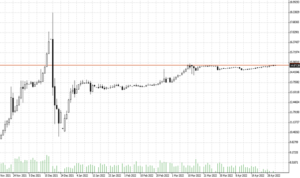

03.05.2022 – Desperate act against the currency’s decline: According to a media report, Istanbul wants to attract foreign investors with high interest rates. Will this stop the decline of the lira? A similar attempt had worked before – but only for a short time. Traders should take a closer look at the matter.
Once again, we have to deal with the Turkish lira. An interesting development is brewing here – a new intervention. At the end of last year, Turkey had already intervened once drastically. The tax office guaranteed to take over losses on lira investments. For example, if investors received 15 percent interest on a one-year investment, but the inflation rate was 20 percent, the government would cover the difference. The term applied to bonds between three and twelve months. The plan led to a short squeeze, but could not prevent the subsequent renewed erosion of the currency, as the daily chart of USDTRY shows.

Source: Bernstein Bank GmbH
De facto, the initial effect has almost evaporated again. Unfortunately, the compensation for the losses was apparently achieved by cranking up the printing press. And with the sale of private investors’ dollar reserves – the financial blog “ZeroHedge” spoke of a clandestine confiscation. Now, it seems, the next round in the game is about to begin. Turkey is in desperate need of foreign exchange reserves. Goldman Sachs sees a hefty shortfall: if swaps with banks and central banks were deducted, the foreign currency reserves position would be minus $57.4 billion as of April 27. Within just one week to that date, Ankara had burned through $1.3 billion.
The new master plan
So the situation is ominous. As a result, Ankara is working on a new plan to attract foreign currency, according to Bloomberg. Investors who leave their greenbacks in the country for at least two years are to receive a 4 percent return in dollars. The central bank also wants to give free lira liquidity to interested foreign investors to invest in local bonds, he said. The translation of this action: Ankara will probably use the firmly invested foreign dollars to support the lira for two years. And then – hopefully – pay them back.
A question of trust
The upshot of all this is that the government’s attempt to lure foreign money could open up long opportunities in the short term. In the long term, however, the lira will only stabilize if investors have confidence in the country. Here, things look bleak – anyone who lowers interest rates in the face of high inflation must be considered not quite in his right mind, to say the least. In March, the inflation rate had climbed by 61.14 percent compared with the same month a year earlier. In February, inflation had already reached 54.44 percent. The situation is unlikely to be much different in April, when the figures will be published.
The approach on the Bosporus is also interesting for other currencies of crisis states. For the Russian ruble, for example. State support, secret intervention, magical price rallies, short squeeze, heavy vola. In other words: exchange rate opportunities for all who anticipate the next steps of politics. Bernstein Bank keeps you up to date.
Important Notes on This Publication:
The content of this publication is for general information purposes only. In this context, it is neither an individual investment recommendation or advice nor an offer to purchase or sell securities or other financial products. The content in question and all the information contained therein do not in any way replace individual investor- or investment-oriented advice. No reliable forecast or indication for the future is possible with respect to any presentation or information on the present or past performance of the relevant underlying assets. All information and data presented in this publication are based on reliable sources. However, Bernstein Bank does not guarantee that the information and data contained in this publication is up-to-date, correct and complete. Securities traded on the financial markets are subject to price fluctuations. A contract for difference (CFD) is also a financial instrument with leverage effect. Against this backdrop, CFD trading involves a high risk up to the point of total loss and may not be suitable for all investors. Therefore, make sure that you have fully understood all the correlating risks. If necessary, ask for independent advice. CFDs are complex instruments and are associated with the high risk of losing money quickly because of the leverage effect. 68% of retail investor accounts lose money trading CFD with this provider. You should consider whether you understand how CFD work and whether you can afford to take the high risk of losing your money.7
